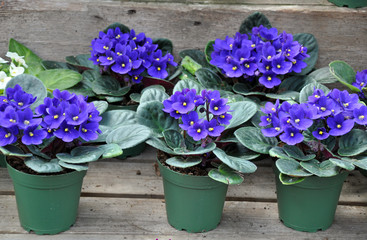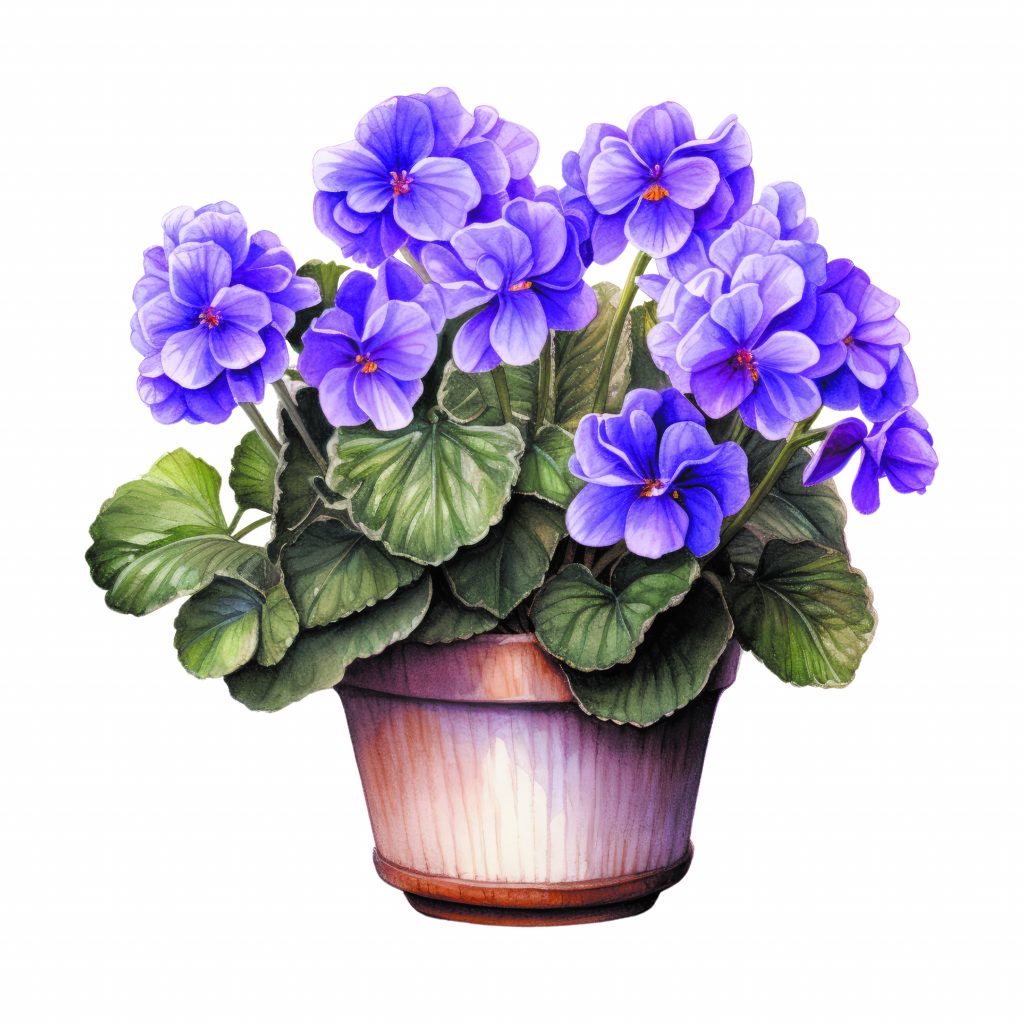


One of the most common houseplants, African Violets (saintpaulia species) are members of the gesneriad family and hail from the tropical rainforest region of east Africa near the border of Tanzania and Kenya. The plant readily flowers in the conditions associated with indoor dwellings. There are seven key elements to growing beautiful violets.
First, light conditions: For best growth and flowering, African violets require bright, indirect sunlight—generally within three feet of a southeast- or west-facing window. Lower light levels for longer periods of time are also adequate. The plant’s leaves will indicate whether light levels are appropriate. If light is too low, leaves are usually thin, deep green, and appear to reach up for light. The plants may grow, but will flower poorly or not at all. Excessive light causes leaves to be pale or greenish-yellow. Growth slows when light is too high and plants become very compact. Flowering will also begin to decrease. These plants are “photo accumulators,” meaning they require a given quantity of light energy before plants will flower. But because they are understory plants, they should never be exposed to full sunlight conditions.
Next, temperature and humidity: African violets prefer temperatures between 60–80°F. During summer months, place plants in the coolest place in the home or in an air-conditioned room. African violets grow best in high humidity, which can be achieved by setting pots in water-tight metal or plastic trays filled with pebbles and water. Do not place pots directly in water as this may cause root rot.
Drainage and soil mixture: Ideal potting mix consists of equal parts of peat moss, vermiculite, and perlite. Soil mixtures should have a pH of about 6.0 to 6.5 (slightly acid) for best results. Pots (clay or plastic) must have drainage holes. Plants in clay pots require more frequent watering than those in plastic pots since evaporation is greater. Be sure to wash pots with soap and water or a bleach solution to prevent cross contamination. African violets bloom best when in small pots, ideally only one-third the diameter of their leaf span. A plant that measures nine inches across should be in a three-inch pot.
Water: It’s not possible to set a watering schedule for African violets. Instead set a daily reminder to check soil conditions and water when soil surfaces begin to dry. African violets bloom best when the roots are well-developed. The best roots form in very porous potting mix which is kept evenly moist at all times—never saturated nor bone dry. African violets may be watered at the soil level or by placing the pot in water. When watering at soil level, water temperature should be slightly higher than room temperature. Saturate the soil and discard excess water that drains through the bottom of the pot. If cold water touches the hairy leaves, it will cause yellowish spots or streaks on the upper leaf surfaces. Watering from the bottom may be done by placing the pot in a container to which about one inch of water is added. When the soil surface becomes moist, remove the pot, allow it to drain, and pour out the excess water.
Finally, fertilization: Water-soluble fertilizers such as 20-20-20 or 15-30-15 are commonly sold for use on African violets. Mix the fertilizer in water at one-fourth the recommended rate and apply it each time you water. Soil should be moist before dissolved fertilizer is applied. Discard excess water and fertilizer solution that drains from the bottom. A gradual loss in leaf color combined with reduced growth and flowering usually indicates that the plant needs fertilizer. Over-fertilized African violets develop tight centers and the new leaves take on a rusty appearance. Trim off the individual flowers as they fade, and when the entire cluster is gone, remove the flower stem by rocking it from side to side until it comes loose from the main stem. This trimming has the effect of increasing future blooming, so it is important to keep up with it.
Propagation of African violets is achieved easily by leaf cuttings. Select a healthy and firm leaf from the middle of the plant and snap or cut it off at the stem leaving the petiole (leaf stem) intact. Trim the petiole to about 1–1 ½ inches in length. A combination of half vermiculite/ half sand, or half vermiculite/half potting mix makes an ideal propagation medium. Insert the petiole into the medium by pushing it into a hole. Roots normally form at the petiole base in three to four weeks, additional leaves appear three to four weeks after roots form, and flowering six to nine months later. Plants with multiple crowns can be propagated by division. Carefully divide the crowns so that each portion has some roots. Then pot each division separately.
Pest management can be achieved with insecticidal soap sprays but leaf and flower damage may occur. Test the product on a leaf or two before spraying the entire plant. Mealy bugs may be controlled with a one to one solution of rubbing alcohol and water. Touch each insect and cottony egg mass with a cotton swab dipped in the solution. Cyclamen mites cause severe stunting of plants and are very difficult to control. Unfortunately, the best management strategy for this pest is to discard affected plants. Root diseases are usually caused by over-watering. The first sign of this problem is usually a limp, unthrifty plant. In most cases the plant should be discarded.




